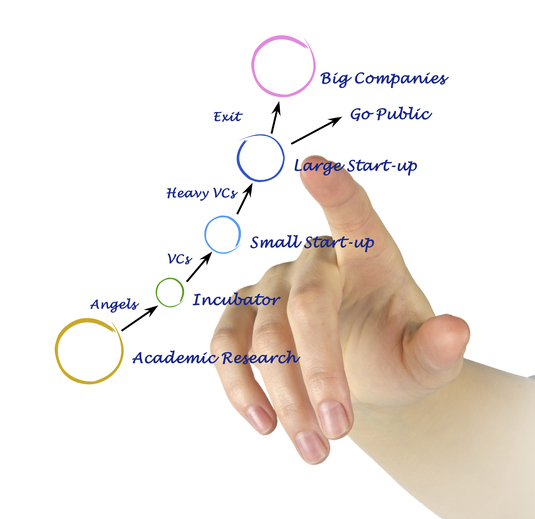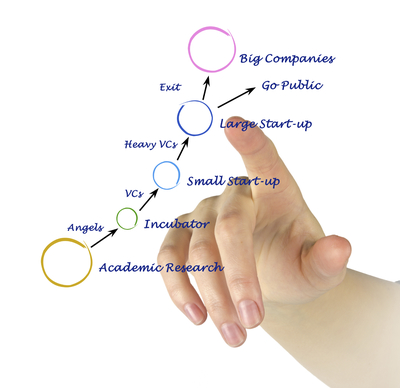Inventors guide
Commercialisation is the process of introducing a new product or production method to the market place, with the intention of creating commercial success and a positive impact for the benefit of wider society. Commercialisation is broken into phases, from the initial discovery of a new idea to its mass production and adoption.
How is research commercialised at Queen’s?
Most commonly, this is achievedthroughan agreement in which Queen's grants to a third party a licence to use Queen's Intellectual Property (IP) in a specific technology. Effectively this rents the IP to another party to undertake the commercialisation. A licence may be limited to a specific type of use, a particular industry sector, and/or for a defined country or geographic region. It may be exclusive or non-exclusive. The third party(the licensee) may be an established company, a start-up or a new Queen's spin-out company. The licence agreement will include conditions that allow Queen's to receive financial payment or to share in the revenue generated from the use of the IP. Revenue received by Queen's in relation to these agreements is shared with the inventors and their respective Faculties.



How long does the process take?
Once initial contact is made with the Commercial Development team, a member will be in touch to help progress your idea. The overall timeframe from disclosing invention through to licensing may take months, or even years. The amount of time depends on the development stage of the technology, the market for the technology, competing technologies, the amount of work needed to bring a new concept to the marketplace, and the resources of the licensee. University technologies are often at too early a stage to attract immediate external investment, and therefore timescales are often lengthened compared to commercial settings. However, Queen's is one of the leading universities in the UK for commercialising research and we can use our experience and knowledge to navigate the commercialisation process as quickly as possible.

IP allows innovations to be treated as an asset in the same way that physical property can.
Ownership of intellectual property
7.6m Annual income from IP commercialisation
Licence agreements
We are committed to finding the best licensee for the technology
Market validation
What activities are required for an invention to reach the market?
Market launchWhat is Research and Enterprise’s role in commercialisation?
Research and Enterprise supports research commercialisation across the University. Our activities include:
Evaluate promising ideas generated by faculty staff;
Protect the inventions by securing IP rights;
Identify and secure funding to support translational activities;
Market innovations to secure external entrepreneurs and/or commercial partners;
Negotiate licence and other agreements with a bearing on IP commercialisation;
Support the development of spin-out companies with strategic guidance, mentoring, office space and access to seed capital.
What is my role?
Commercialisation begins with the quality of the original research and the technical ability of the Principal Investigator (PI) and their research team. As an inventor you can play an active role in commercialising your research by:
- Contacting the Commercial Development team when you believe you have a scientific or technical observation with commercial potential or have engaged with an external company or entrepreneur to develop an idea.
- Completing and submitting an Invention Disclosure Form (IDF). The IDF is the first detailed record of your invention and helps to establish the intellectual property rights (IPR) position. In order to preserve potential patent rights, we strongly encourage you not to disclose your invention in any public forum (including lectures, presentations, posters, abstracts, websites, research proposals, dissertation/master’s thesis, publications, or other public descriptions).
- Keeping a record of the work that led to the invention. This often means maintaining a physical or digital laboratory notebook which documents the conception and delivery (or embodiment) of an invention.
- Helping us understand the context of your invention by identifying potential companies or entrepreneurs that you are aware of which, or who, work in the same technology sector or produce related products. When completing the IDF, include companies and contacts you believe might be interested in your invention or who may have already contacted you about it. The inventors often have invaluable knowledge of the market as well as the technology and this input often leads to more successful commercial outcomes.
- Helping us to respond to technical questions from interested companies and being prepared to engage with and meet prospective business partners and licensees.
- Helping us secure the best possible IP protection, by responding to us and our external partners (such as patent agents). A patent application will rarely be filed without engagement and insight from the inventor, and often will not be granted without technical guidance from the inventor as the application is examined.
- Engaging with your nominated contact in the Commercial Development team. Let us know about significant technology developments, upcoming publications and interactions with companies related to your invention.